Avery ALS 380 User Manual
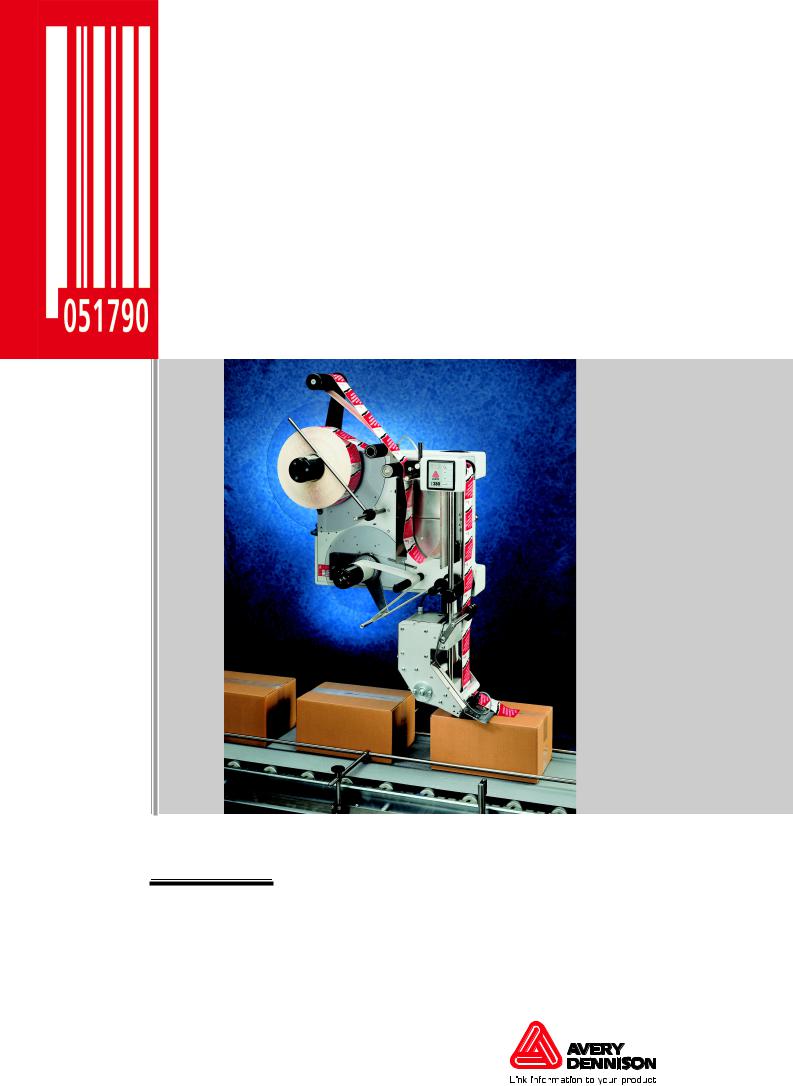
OPERATING MANUAL
Label Dispenser
ALS
380
Article number: A6392, Release 06.2005

|
CONTENTS |
ALS |
|
|
380 |
|
|
|
1 Please observe the following
1.1 General information . . . . . . . . . . . . . . 4
1.1.1 Validity and applicability of this manual . . . . . 4
Contents . . . . . . . . . . . . . . . . . . . . . . . . . . . . . . . 4 Technical State . . . . . . . . . . . . . . . . . . . . . . . . . . 4 Copyright notice . . . . . . . . . . . . . . . . . . . . . . . . . 4 Manufacturer . . . . . . . . . . . . . . . . . . . . . . . . . . . . 4
1.1.2 Conventions and information . . . . . . . . . . . . . 5
Explanation of symbols . . . . . . . . . . . . . . . . . . . . 5 Warnings concerning dangers and risks . . . . . . . 5 Illustrations . . . . . . . . . . . . . . . . . . . . . . . . . . . . . 5 Supplemental information . . . . . . . . . . . . . . . . . . 5 Directional information. . . . . . . . . . . . . . . . . . . . . 6
1.2 Safety instructions . . . . . . . . . . . . . . . 7
1.2.1 Information and qualifications . . . . . . . . . . . . . 7
Pay attention to the information. . . . . . . . . . . . . . 7 Information must be made available . . . . . . . . . . 7 Ensure necessary qualifications . . . . . . . . . . . . . 7
1.2.2 Machine operating safety . . . . . . . . . . . . . . . . 8
Appropriate use . . . . . . . . . . . . . . . . . . . . . . . . . . 8 Protect against injuries that can result from electrical current . . . . . . . . . . . . . . . . . . . . . . . . . 8 Protect against injuries that can result from mechanical actions . . . . . . . . . . . . . . . . . . . . . . . 8 Protection against chemicals. . . . . . . . . . . . . . . . 8
1.2.3 Before every production start . . . . . . . . . . . . . 9
Operator's obligation and service personal to exercise care . . . . . . . . . . . . . . . . . . . . . . . . . . . . 9 Operating personnels' obligation to exercise
care . . . . . . . . . . . . . . . . . . . . . . . . . . . . . . . . . . . 9
2 Equipment description
2.1 Overview . . . . . . . . . . . . . . . . . . . . . 10
2.1.1 Structural elements . . . . . . . . . . . . . . . . . . . . 10 2.1.2 Principle of operation . . . . . . . . . . . . . . . . . . 11
2.1.3 Technical data. . . . . . . . . . . . . . . . . . . . . . . . 12
Characteristic values . . . . . . . . . . . . . . . . . . . . . 12 Labels . . . . . . . . . . . . . . . . . . . . . . . . . . . . . . . . 12 Ambient conditions . . . . . . . . . . . . . . . . . . . . . . 12 Dimensions . . . . . . . . . . . . . . . . . . . . . . . . . . . . 12 Casing . . . . . . . . . . . . . . . . . . . . . . . . . . . . . . . . 12 Electrical system . . . . . . . . . . . . . . . . . . . . . . . . 12 Control system . . . . . . . . . . . . . . . . . . . . . . . . . 12 Emissions . . . . . . . . . . . . . . . . . . . . . . . . . . . . . 12
2.1.4 Design versions . . . . . . . . . . . . . . . . . . . . . . 13
Top-labeller right-hand version . . . . . . . . . . . . .13 Side-labeller right-hand version. . . . . . . . . . . . .13 Top-labeller left-hand version . . . . . . . . . . . . . .14 Side-labeller left-hand version . . . . . . . . . . . . . .14
2.1.5 Options. . . . . . . . . . . . . . . . . . . . . . . . . . . . . 15
High-speed processing version ALS 380 HS . .15 Serial interface. . . . . . . . . . . . . . . . . . . . . . . . . .15 Roll diameter control . . . . . . . . . . . . . . . . . . . . .15 Adjustable dispensing edge. . . . . . . . . . . . . . . .15 Printer . . . . . . . . . . . . . . . . . . . . . . . . . . . . . . . .15 Applicator. . . . . . . . . . . . . . . . . . . . . . . . . . . . . .15
2.2 Operator controls . . . . . . . . . . . . . . . 16
2.2.1 Operator panel . . . . . . . . . . . . . . . . . . . . . . . 16
LED indicator . . . . . . . . . . . . . . . . . . . . . . . . . . .16 Keys. . . . . . . . . . . . . . . . . . . . . . . . . . . . . . . . . .16
2.2.2 Main switch . . . . . . . . . . . . . . . . . . . . . . . . . 17
2.3 Control system . . . . . . . . . . . . . . . . . 18
2.3.1 Brief description . . . . . . . . . . . . . . . . . . . . . . 18
2.3.2 Menus for operators and calibration technicians . . . . . . . . . . . . . . . . . . . . . . . . . . 19
2.3.3 Monitoring functions. . . . . . . . . . . . . . . . . . . 20
Dispensing a label to each product . . . . . . . . . .20 Label supply . . . . . . . . . . . . . . . . . . . . . . . . . . .20 If errors occur . . . . . . . . . . . . . . . . . . . . . . . . . .20
3 Prior to operating
3.1 Insert the labelling material . . . . . . . 21
3.1.1 Prerequisites . . . . . . . . . . . . . . . . . . . . . . . . 21
3.1.2 Insert the label roller. . . . . . . . . . . . . . . . . . . 21
Remove the old backing material . . . . . . . . . . .21 Remove adhesive residues . . . . . . . . . . . . . . . .21 Insert new label roll . . . . . . . . . . . . . . . . . . . . . .22
3.1.3 Threading the label ribbon . . . . . . . . . . . . . . 23
Overview of the threading path diagram . . . . . .23 Thread the label ribbon at the unwind unit. . . . .24 Thread in the label ribbon at the dispensing edge. . . . . . . . . . . . . . . . . . . . . . . . . . . . . . . . . .25 Thread the label ribbon at the rewind unit. . . . .26
1

|
CONTENTS |
ALS |
|
|
380 |
|
|
|
3.2 Mechanical settings . . . . . . . . . . . . . 27
3.2.1 Setting the ribbon guides . . . . . . . . . . . . . . . 27
Operator panel support . . . . . . . . . . . . . . . . . . . 27 Deflection rollers on the rewind unit . . . . . . . . . 27
3.2.2 Adjusting the braking brushes. . . . . . . . . . . . 28 3.2.3 Adjusting the pressure rollers . . . . . . . . . . . . 29
3.2.4Adjust the pressure roller unit (optional) at
the dispensing edge.. . . . . . . . . . . . . . . . . . . 30
3.2.5Adjust (optional) the position of the
dispensing edge.. . . . . . . . . . . . . . . . . . . . . . 31
Adjusting vertically. . . . . . . . . . . . . . . . . . . . . . . 31
4.3 Product databanks . . . . . . . . . . . . . . 48
4.3.1 Functions . . . . . . . . . . . . . . . . . . . . . . . . . . . 48
4.3.2 Loading product data banks. . . . . . . . . . . . . 48
Please observe:. . . . . . . . . . . . . . . . . . . . . . . . .48 Activating product databanks at switch-on . . . .49 Activating product databanks after switch-on . .49
4.3.3 Create/save product databank. . . . . . . . . . . 50
Prerequisites . . . . . . . . . . . . . . . . . . . . . . . . . . .50 Saving the product databank. . . . . . . . . . . . . . .50 Documenting product databanks. . . . . . . . . . . .50
4.3.4 Deleting a product databank . . . . . . . . . . . . 51
4 Operation
4.1 Activation and shut-down. . . . . . . . . 32
4.1.1 Starting the machine . . . . . . . . . . . . . . . . . . . 32
Automatic material initialisation . . . . . . . . . . . . . 32 Manually initialise the material . . . . . . . . . . . . . 33
4.1.2 Labelling . . . . . . . . . . . . . . . . . . . . . . . . . . . . 34
Prerequisites . . . . . . . . . . . . . . . . . . . . . . . . . . . 34 Start dispensing labels . . . . . . . . . . . . . . . . . . . 35 Unwind unit . . . . . . . . . . . . . . . . . . . . . . . . . . . . 36 Rewind unit . . . . . . . . . . . . . . . . . . . . . . . . . . . . 36
4.1.3 Stop/end the label dispensing. . . . . . . . . . . . 36
4.1.4 Tandem operation. . . . . . . . . . . . . . . . . . . . . 37
Principle of operation. . . . . . . . . . . . . . . . . . . . . 37 Prerequisites . . . . . . . . . . . . . . . . . . . . . . . . . . . 38 Start dispensing labels . . . . . . . . . . . . . . . . . . . 38 Reloading label material . . . . . . . . . . . . . . . . . . 39 Switching off . . . . . . . . . . . . . . . . . . . . . . . . . . . 40
4.2 Setting and monitoring. . . . . . . . . . . 41
4.2.1 Settings in the standard menu . . . . . . . . . . . 41
Overview . . . . . . . . . . . . . . . . . . . . . . . . . . . . . . 41 Calling up menu . . . . . . . . . . . . . . . . . . . . . . . . 41 Call up function . . . . . . . . . . . . . . . . . . . . . . . . . 41
4.2.2 Label stop position (STOD). . . . . . . . . . . . . . 42
4.2.3 Dispensing speed (VELO) . . . . . . . . . . . . . . 43
Automatic dispensing speed (optional) . . . . . . . 43
4.2.4 Label position on the product (POS). . . . . . . 44 4.2.5 Automatic material initialisation (INIT) . . . . . 45 4.2.6 If errors occur . . . . . . . . . . . . . . . . . . . . . . . . 46
4.4 Settings in the extended menu. . . . . 52
4.4.1 Overview . . . . . . . . . . . . . . . . . . . . . . . . . . . 52
4.4.2 Activating an extended menu. . . . . . . . . . . . 54
Please observe:. . . . . . . . . . . . . . . . . . . . . . . . .54 Calling up menu. . . . . . . . . . . . . . . . . . . . . . . . .54 Call up function . . . . . . . . . . . . . . . . . . . . . . . . .54 Exit the extended menu. . . . . . . . . . . . . . . . . . .54
4.4.3 Position of second label (POS2) . . . . . . . . . 55 4.4.4 Position of third label (POS3). . . . . . . . . . . . 55 4.4.5 Speed ratio (VERT) . . . . . . . . . . . . . . . . . . . 56
4.4.6 Adjust the label stop sensor (CONT) . . . . . . 57
Technology . . . . . . . . . . . . . . . . . . . . . . . . . . . .57 Automatically adjusting the photoelectric
sensor . . . . . . . . . . . . . . . . . . . . . . . . . . . . . . . .57 Manually adjusting the sensor. . . . . . . . . . . . . .58
4.4.7 Label distance (LPIT). . . . . . . . . . . . . . . . . . 59
Check setting. . . . . . . . . . . . . . . . . . . . . . . . . . .59
4.4.8 Distance from the label stop sensor to the dispensing edge (E–SS). . . . . . . . . . . . . . . . . . 60
Set distance. . . . . . . . . . . . . . . . . . . . . . . . . . . .60 Check setting. . . . . . . . . . . . . . . . . . . . . . . . . . .61
4.4.9 Product length (PRDL) . . . . . . . . . . . . . . . . . 62 4.4.10 Polarity of the product sensor (P_S_) . . . . . 63 4.4.11 Polarity of the label stop sensor (S_S_). . . . 63 4.4.12 Number of unlabelled products (MLAB) . . . . 64
4.4.13 Electronic transmission ratio of the
RPM transmitter (EGRA) . . . . . . . . . . . . . . . 64 4.4.14 Advance print start (PDT). . . . . . . . . . . . . . . 65 4.4.15 Printer dwell time (PDWT) . . . . . . . . . . . . . . 65 4.4.16 Tandem operation (TMOD) . . . . . . . . . . . . . 66
2

CONTENTS
4.4.17 Applicator type (APPL) . . . . . . . . . . . . . . . . . 66 4.4.18 EP cylinder dwell time (APT1) . . . . . . . . . . . 66 4.4.19 Blowing time (APT2) . . . . . . . . . . . . . . . . . . . 66 4.4.20 Delay time (APT3). . . . . . . . . . . . . . . . . . . . . 66 4.4.21 Fine tuning of the dwell time (APT4). . . . . . . 66 4.4.22 Delete a product data bank load (LOAD) . . . 66 4.4.23 Create/save product data bank (SAVE) . . . . 66 4.4.24 Delete a product data bank (DEL) . . . . . . . . 66
4.5Automatic dispensing speed
(APSF). . . . . . . . . . . . . . . . . . . . . . . 67
4.5.1 Electronic transmission ratio of the
RPM transmitter (EGRA) . . . . . . . . . . . . . . . 68
Setting the compensation factor . . . . . . . . . . . . 68 Test the setting:. . . . . . . . . . . . . . . . . . . . . . . . . 68
ALS 380
5 After operation
5.1 Care and cleaning . . . . . . . . . . . . . . 73
5.1.1 Cleaning agents . . . . . . . . . . . . . . . . . . . . . . 73
5.1.2 Regular maintenance. . . . . . . . . . . . . . . . . . 73
Remove paper waste. . . . . . . . . . . . . . . . . . . . .74 Braking brushes. . . . . . . . . . . . . . . . . . . . . . . . .74 Capacitive sensor at the dispenser head . . . . .75
6 Operational malfunctions
6.1 Warning messages. . . . . . . . . . . . . . 76
6.1.1 Please observe: . . . . . . . . . . . . . . . . . . . . . . 76 6.1.2 If a problem occurs. . . . . . . . . . . . . . . . . . . . 76 6.1.3 Warning messages . . . . . . . . . . . . . . . . . . . 76
4.6 Applicator (optional). . . . . . . . . . . . . 69
4.6.1 Principle of operation . . . . . . . . . . . . . . . . . . 69
4.6.2 Functions in the extended menu. . . . . . . . . . 70
Please observe the following. . . . . . . . . . . . . . . 70 Calling up the extended menu. . . . . . . . . . . . . . 70 Applicator type (APPL) . . . . . . . . . . . . . . . . . . . 70 EP cylinder dwell time (APT1). . . . . . . . . . . . . . 71 Blowing time (APT2) . . . . . . . . . . . . . . . . . . . . . 71 Delay time (APT3) . . . . . . . . . . . . . . . . . . . . . . . 71 Fine tuning of the dwell time (APT4) . . . . . . . . . 72
6.2 Error messages . . . . . . . . . . . . . . . . 78
6.2.1 If a malfunction occurs . . . . . . . . . . . . . . . . . 78 6.2.2 Error codes. . . . . . . . . . . . . . . . . . . . . . . . . . 78
7 Appendix
7.1 Factory settings . . . . . . . . . . . . . . . . 82 7.2 Product data banks . . . . . . . . . . . . . 84
7.3 EC Declaration of Conformity. . . . . . 86
3

|
1 |
PLEASE OBSERVE THE FOLLOWING |
ALS |
|
1.1 |
GENERAL INFORMATION |
380 |
|
|
||
|
|
|
|
1.1.1 Validity and applicability of this manual
Contents
The present manual refers exclusively to the ALS 380 Labeller and the high-speed ALS 380 HS version. The manual is to be referred to for correct operation and adjustment of the machine.
The prerequisites for operation and adjustment are proper installation and configuration of the machine.
For technical questions which are not addressed in this operating manual:
Refer to the Service Guide for the ALS 380 Labeller or
consult the servicing technician of our sales partner.
– The responsible servicing technician of our sales partner is at your disposal and particularly helpful with configuration settings and remedying malfunctions.
Copyright notice
All rights to this operating manual are assigned to Avery Dennison. Transmission, reprinting or any other means of reproduction of this manual, whether whole or in part, are not allowed without prior written permission. Third parties, in particular competitors, are not to be allowed access to information derived from this manual.
Printed in Germany
Manufacturer
Avery Dennison Deutschland GmbH Ohmstraße 3
D - 85386 Eching Phone: +49-8165-925-0 FAX: +49-8165-3143
http://www.machines.averydennison.com
Technical State
Technical state as of: 06/2005
Software versions
ALS 380: 6.1
ALS 380 HS: Master 1.1, Slave 1.0
Avery Dennison reserves the right to:
–implement modifications of structural parts, components and software as well as to use equivalent components that keep pace with the current state of technology in lieu of the specified components.
–change information contained in this manual.
An obligation to extend these modifications to previously delivered machines is excluded.
4
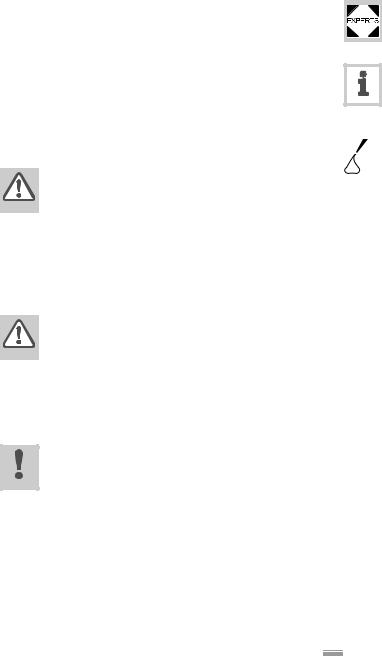
|
1 |
PLEASE OBSERVE THE FOLLOWING |
ALS |
|
1.1 |
GENERAL INFORMATION |
380 |
|
|
||
|
|
|
|
1.1.2 Conventions and information
Explanation of symbols
In order to facilitate legibility and an overview, the various types of information used herein are categorised and identified with certain symbols.
Sentences that are introduced by an arrow contain procedural instructions.
Carry out procedural instructions one after the other in the prescribed order.
Illustrations
When required, text passages are accompanied by illustrations. The reference to an illustration is indicated by typesetting the [illustration number] in square brackets. Capital letters following an illustration number, e.g. [12A], refer to the corresponding position indicated in the illustration.
The following information is introduced with a dash:
–List items
–Descriptions of conditions
–Description of previous work steps
–Prerequisites for implementing actions described in the following passage
Warnings concerning dangers and risks
Important text passages which must absolutely be followed are particularly marked for special attention:
DANGER!
A danger notice indicates an imminent hazardous situation which, if not avoided, could result in death or serious injury of the personnel!
The notice contains instructions on how to avoid or prevent the danger(s).
The instructions must be followed.
WARNING!
A warning notice indicates risks which could result in death or serious injury of the personnel! The notice contains safety instructions on how to safeguard possibly affected personnel.
The instructions must be followed.
CAUTION!
A caution notice indicates risks which, if unheeded, could lead to material damage or bodily injury (minor injuries). The notice contains instructions on how to prevent damage or injury.
The instructions must be followed.
Supplemental information
The "Experts" symbol earmarks activities that only to be performed by knowledgeable and trained personnel.
The information symbol indicates notices and recommendations as well as additional helpful information.
Operating materials:
–Operating materials, e.g. lubricants or cleaning agents
5
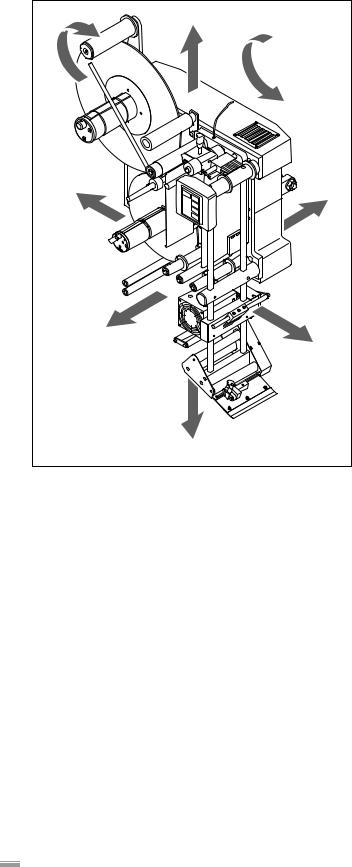
|
1 |
PLEASE OBSERVE THE FOLLOWING |
ALS |
|
1.1 |
GENERAL INFORMATION |
380 |
|
|
||
|
|
|
|
Directional information
Unless otherwise indicated, the directional information mentioned in the text refers to the construction of the right-hand version of Top Labeller. See Figure [1] for the explanation of directional information.
G |
C |
|
H |
E |
B |
|
|
|
A |
|
F |
|
D |
[1]Definition of directional information A Front
B Rear
C Upward
D Downward E Left
F Right
G Clockwise
H Counter-clockwise
6

|
1 |
PLEASE OBSERVE THE FOLLOWING: |
ALS |
|
1.2 |
SAFETY INSTRUCTIONS |
380 |
|
|
||
|
|
|
|
1.2.1 Information and qualifications
Pay attention to the information
WARNING!
Reliable and safe operation of the labeller is only guaranteed if all necessary information is observed!
Read this operating manual thoroughly and observe all notices prior to operation.
Observe all additional safety and warning notices attached to the labeller.
Only allow qualified persons to operate and adjust the labeller.
Ensure necessary qualifications
Only allow the machine to be operated, adjusted and serviced by instructed and authorised personnel.
Adjustment tasks via the expanded menus as well as programming and administration of product databases are only to be performed by qualified and appropriately trained personnel or by the responsible servicing technician.
The responsibilities for operation, adjustment and servicing of the machine must be clearly defined and consistently maintained.
Information must be made available
This operating manual
is to stored at the machine operating location and made accessible to the operator.
is to maintained in legible condition.
is to be made available to the new owner if the machine is sold.
Safety and warning notices attached to the labeller must be kept clean and legible. Missing or damaged warning labels and plates are to be replaced.
Moreover, personnel are to be regularly instructed about work safety and environmental protection issues.
Operator qualifications
Instruction of the operating personnel must ensure:
–that operating personnel can use the machine independently and without posing a danger.
–that operating personnel can remedy minor operational malfunctions themselves.
Train at least 2 person to operate the machine.
Make label materials for test purposes available in sufficient quantities.
Qualifications for adjustment tasks
Settings in the expanded menus of the control software require knowledge based on experience:
–The adjustment personnel must be familiar with how the labeller functions.
–Adjustment personnel must be familiar with the entire system into which the labeller is integrated.
–Adjustment personnel must be able to correctly apply the functions in the expanded menu system to appropriately address the order-specific requirements.
7

|
1 |
PLEASE OBSERVE THE FOLLOWING: |
ALS |
|
1.2 |
SAFETY INSTRUCTIONS |
380 |
|
|
||
|
|
|
|
1.2.2 Machine operating safety
Appropriate use
The ALS 380 labeller is a fully automatic machine for the application of self-adhesive labels to products or packages. The machine is to be equipped by the operation planners with suitable safety devices so as to protect the operating personnel from possible endangerment – e.g. pinching or entrapment of body parts due to reaching between product and dispensing edge.
WARNING!
Improper usage of the machine can lead to accidents, material damage and loss of production!
Only operate this machine in accordance with information contained in this manual.
Do not put the machine into operation without the required safety equipment in place.
Only make adjustments to the machine in accordance with this manual and with all due care.
Protect against injuries that can result from electrical current
WARNING!
The machine is connected with the mains supply! Contact with energised components can result in life-endangering currents through the body as well as burns.
Only put the machine into operation when installed in a correctly installed housing.
–The housing may only be removed by trained personnel when the machine is
de-energised.
Pull out the mains power connection plug from the socket before cleaning and maintenance.
The machine is not protected against splashing water.
Maintain the machine in a dry condition.
In case fluids penetrate into the machine interior, immediately switch off the machine and disconnect or plug out from the mains power supply. Notify a servicing technician.
Protect against injuries that can result from mechanical actions
WARNING!
Risk of injury due to moving or rapidly rotating parts!
The following regulations always apply:
Keep a distance from running machines. Wear snug-fitting clothing and hair nets.
Even when the machine is idle, maintain the area clear of movable parts if the possibility exists that the machine could start.
Never lay tools or loose parts on the machine if the possibility exists that the machine could start.
Switch off the machine before performing mechanical adjustment tasks.
Do not wear ties, loose garments, jewellery, watches or similar articles on the body when in the machine vicinity.
CAUTION!
Danger of body part trapping and pinching at the dispensing edge due to products moving in the conveyor direction!
Never reach between the product and dispensing edge of running or operationready machines.
During operation, never remove or defeat the purpose of protective guards that prevent reaching into the machine.
Protection against chemicals
CAUTION!
Operational materials such as cleaning agents or adhesive solvents may pose a health risk.
Rules, work guidelines and safety regulations issued by the manufacturer must absolutely be followed!
8

|
1 |
PLEASE OBSERVE THE FOLLOWING: |
ALS |
|
1.2 |
SAFETY INSTRUCTIONS |
380 |
|
|
||
|
|
|
|
1.2.3 Before every production start
Operator's obligation and service personal to exercise care
Ensure the following prerequisites correspond to the information of the operating manual:
–The machine is correctly installed and appropriately configured for the requirements.
–All necessary safety equipment is installed.
–The machine has successfully completed at least one test run.
–The machine is connected to the power supply.
The required personal safety gear, e.g. hair nets, must be provided. Make sure that the safety gear is used in accordance with the regulations.
Operating personnels' obligation to exercise care
Verify flawless functioning of the safety equipment.
Check machine for visible damage. Any discovered deficiency is to be reported immediately.
Use personal safety gear in accordance with the regulations, e.g. wear hair nets.
Non-required materials and objects are to be removed from the working area of the machine.
Make sure that only persons authorised to work on the machine are within the working area of the machine.
Make sure that no one will be placed in a hazardous situation as a result of the machine startup.
9
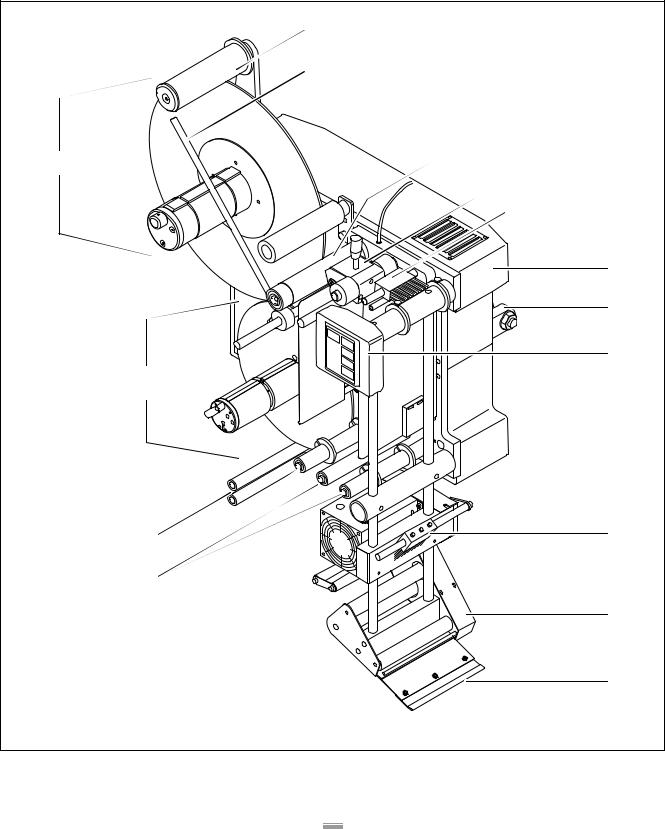
|
2 |
EQUIPMENT DESCRIPTION |
ALS |
|
2.1 |
OVERVIEW |
380 |
|
|
||
|
|
|
|
2.1.1 Structural elements
|
B |
|
C |
A |
D |
|
E |
|
F |
|
G |
|
H |
|
I |
M |
|
N |
J |
O |
|
|
K |
|
L |
[2]Right-hand version of the ALS 380 Labeller
10

2 EQUIPMENT DESCRIPTION
2.1 OVERVIEW
A Unwind unit
–The unwinding spindle holds the label roll.
–The spreader mechanism (chucking wedge) secures the label roll.
BDancer arm of the unwind unit
– spring-loaded and rotatable
CGuiding rod for unwind unit
– Also secures the label roll.
DDrive roller unit of the unwind unit
EPressure roller of the unwind unit
FBraking brush up
–Allows label ribbon to run smoothly, prevents fluttering.
G Casing
–Houses the control electronics, drive electrical system, main switch, and fuses.
H Mounting brackets
– For securing the machine in the system.
IOperator panel
JBraking brush down
KDispenser head
–With integrated label feed
–Optionally equipped with printer or applicator
L Dispensing edge
– The label separates from the backing material here. M Rewind unit
–An electrically driven rewinding roller takes up the empty backing material.
–A spreader mechanism secures the backing material roll.
NDancer arm of the rewind unit
– spring-loaded and rotatable
ODeflection rollers of the rewind unit
ALS 380
2.1.2 Principle of operation
In labelling mode, the unwind unit [2A] and the drive roller unit move the [2D] label ribbon. A loop is formed in the label ribbon between the pressure roller of the unwind unit [2E] and the upper braking brush [2F]. An additional drive roller unit in the dispenser head [2K] pulls the ribbon over the dispensing edge [2L]. The label separates from the backing material at the dispensing edge.
The drive roller unit in the dispensing head moves the respective ribbon for a label and then stops until the next product takes the label under the dispensing edge. Label ribbon is continuously unwound at the unwind unit. The loop acts as a buffer between the continuously operating unwind unit and the periodically operating label output. The braking brushes keep the label ribbon taut.
From the dispensing head, the empty backing material runs over several deflection rollers [2O] to the mo- tor-driven spreaderrewinding unit [2M]. The multiple deflections with the spring-loaded dancer arm [2N] act as a buffer between the label output and the rewind unit.
The entire operation of the labeller is electronically controlled and monitored. If a malfunction occurs, the control system sends a corresponding message to the operator. If necessary, the labelling operation is automatically halted. An electronic signal is issued at the same time. The signal can be picked up by an external control system.
11

2 EQUIPMENT DESCRIPTION
2.1 OVERVIEW
2.1.3 Technical data
Characteristic values
Dispensing speed |
0.5 m/min to 80 m/min |
ALS 380: |
|
ALS 380 HS: |
0.5 m/min to 100 m/min |
|
|
Stop accuracy (at the |
|
dispensing edge): |
± 0.5 mm |
|
|
Rewind unit: |
Spreader mechanism |
|
|
Label sensor: |
Manual or automatic set- |
|
ting |
|
|
Operation: |
programmable, can be set |
|
via the operator panel, |
|
The settings can be stored |
|
in 11 data banks |
|
|
Speed control: |
Automatic dispensing |
|
speed, with RPM- |
|
transmitter |
|
|
Labels
Label width
(incl. backing material): max. 155 mm
Label length at |
|
maximum dispensing |
min. 16 mm |
speed: |
max. 250 mm 1) |
Label roll |
|
Outer diameter |
max. 400 mm |
Core diameter: |
76.2 mm |
|
|
Distance from dispens- |
|
ing edge to label sen- |
min. 20 mm |
sor: |
|
1) Longer labels are possible when product distance is increased accordingly
Ambient conditions
Temperature |
|
Operation: |
5°C to 40°C |
Storage: |
5°C to 70°C |
|
|
Relative humidity: |
30 % to 80 %, |
|
not condensing |
|
|
ALS 380
Dimensions
Dimensions |
|
Width: |
735 mm |
Height: |
795 mm |
Depth: |
400 mm |
|
|
Weight |
50 kg |
ALS 380: |
|
ALS 380 HS: |
55 kg |
|
|
Casing
Covering for the control- |
Polyurethane (PUR), |
electronics: |
10 mm thick |
|
|
Front plate: |
Aluminium, anodized, |
|
15 mm thick |
|
|
Electrical system
Power consumption: |
500 |
VA |
|
|
|
|
|
Mains connection |
|
|
|
Nominal voltage: |
110 |
V / |
120 V / 130 V / |
|
200 |
V / |
220 V / 230 V/ |
|
240 V 1) |
||
Frequency: |
50 Hz / |
60 Hz 1) |
|
Type of protection |
IP41 (protected against |
||
|
vertically falling drops of |
||
|
water, not protected |
||
|
against sprayed water) |
||
|
|
||
Drive system: |
2 stepping motors, |
||
|
1 AC motor |
||
|
|
|
|
1) Customer options |
|
|
|
Control system
Control electronics: |
Integrated |
|
|
Options: |
V24 interface |
|
Frequency inverter for |
|
motor control |
|
|
Emissions
Sound pressure level at |
|
a distance of 1 m: |
75 db (A) |
12
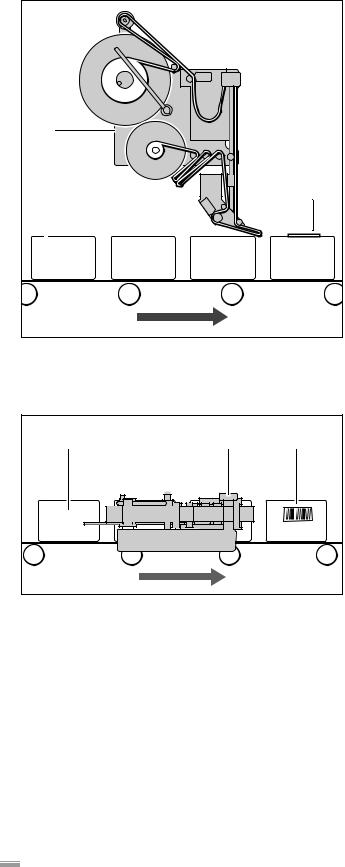
|
2 |
EQUIPMENT DESCRIPTION |
ALS |
|
2.1 |
OVERVIEW |
380 |
|
|
||
|
|
|
|
2.1.4 Design versions
The ALS 380 labeller is available in 4 different versions, depending on the taskat hand:
Top-labeller right-hand version
–Labelling from above onto the upper side of the product [3].
–The products are conveyed from left to right.
–The dispensing edge is located on the right side.
Side-labeller right-hand version
–Labelling from the side onto one of the product’s sides [4].
–The products are conveyed from left to right.
–The dispensing edge is located on the right side.
A |
|
B |
C |
[3]Top-labeller right-hand version A ALS 380 labeller
B Product on conveyor line C Labelled product
B |
A |
C |
[4]Side-labeller right-hand version A ALS 380 labeller
B Product on conveyor line C Labelled product
13
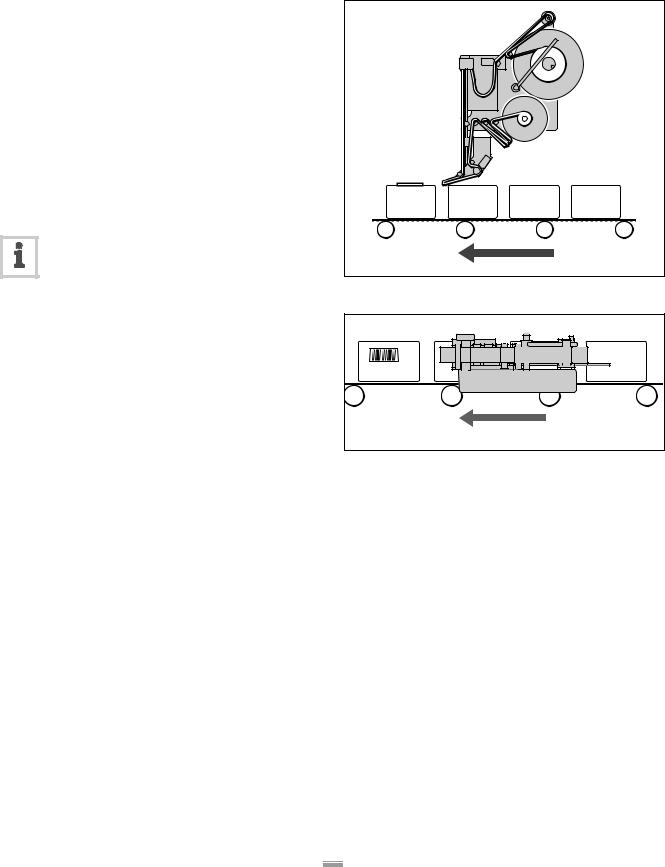
|
2 |
EQUIPMENT DESCRIPTION |
ALS |
|
2.1 |
OVERVIEW |
380 |
|
|
||
|
|
|
|
Top-labeller left-hand version
–Labelling from above onto the upper side of the product [5].
– The products are conveyed from right to left.
– The dispensing edge is located on the left side.
Side-labeller left-hand version
– Labelling from the side onto one of the product’s sides [6].
– The products are conveyed from right to left.
– The dispensing edge is located on the left side.
Labeller operation is described in these instructions based on the top-labeller right-hand de-
sign version.
Other design versions are only considered if [5] Top-labeller left-hand version their descriptions or illustrations differ.
[6] Side-labeller left-hand version
14

2 EQUIPMENT DESCRIPTION
2.1 OVERVIEW
2.1.5 Options
High-speed processing version
ALS 380 HS
–Allows dispensing speeds up to 100 m/min
–Available in all of the above-mentioned design versions.
Serial interface
–Almost all of the setting values can be read out and modified on an external device, the machine status can be queried, and the machine can be controlled via this interface.
Roll diameter control
–A sensor at the unwind unit monitors the diameter of the label roll and, along with it, the supply of labels.
–The sensor sends a signal when the diameter of the label roll reaches a set value.
–This sensor is required if two labellers are operating in tandem mode (see chapter Operation - Activation and shut-down, Tandem operation)
Adjustable dispensing edge
–The position of the dispenser head can be adjusted vertically.
–This allows adapting the position of the dispensing edge to changing products.
–The machine does not have to be moved to adjust the dispensing edge. The labelling head of the machine does not have to be released.
ALS 380
Printer
– Inkjet or heat transfer printer at the dispenser head.
Applicator
If direct labelling from the dispensing edge is not possible, the labeller can be equipped with an applicator. Various kinds of applicators are available depending on the customer’s needs.
15
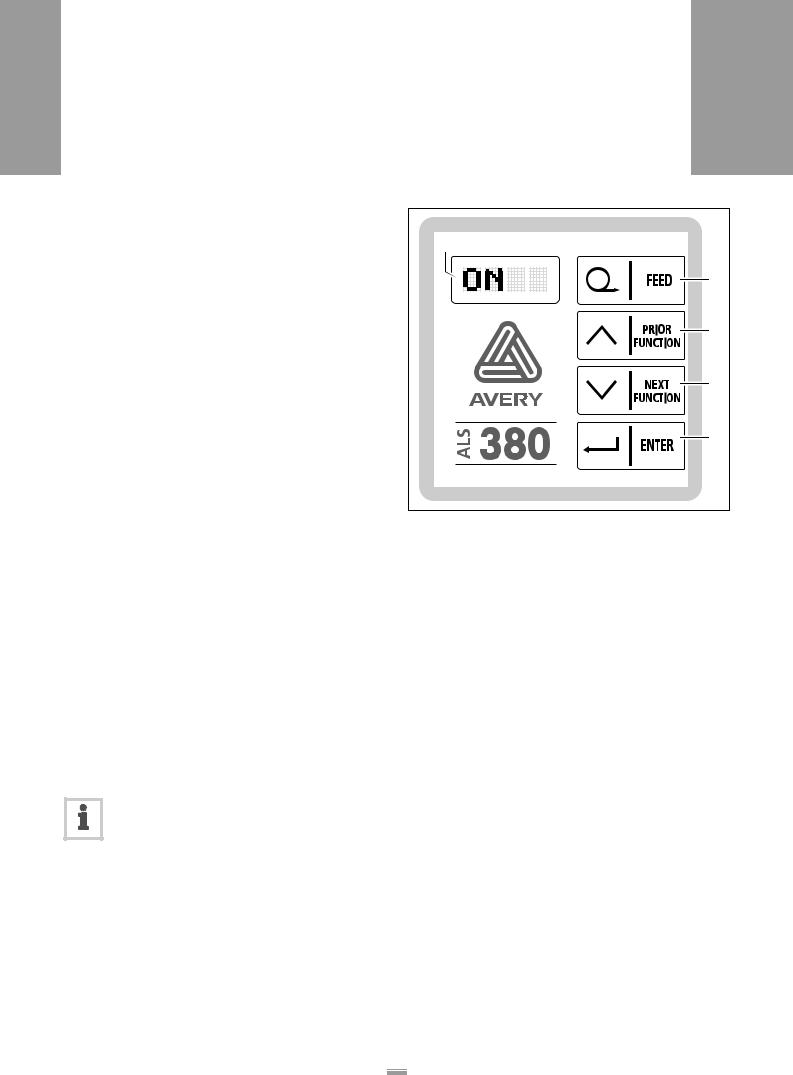
2 EQUIPMENT DESCRIPTION
2.2 OPERATOR CONTROLS
2.2.1 Operator panel
LED indicator
–Display of functions, setting values, operating states, error messages, and warning messages
If the LED indicator is ON:
–The machine is in labelling mode.
–Each time the product sensor is triggered, a label is dispensed.
If the LED indicator is OFF:
– Labelling mode is switched off.
Keys
FEED
–When this key is pressed, the machine dispenses a label.
PRIOR (previous function)
–Paging through the functions in the menu: to see the previous function, page upward.
–Within a function: increase the current value
NEXT (next function)
–Paging through the functions in the menu: to see the next function, page downward.
–Within a function: decrease current value
ENTER
–Activate or switch off labelling mode.
–Call up or end functions.
–Acknowledge error and warning messages.
Depending on the menu and the operating state of the machine, special key functions are also available. Where special functions are available, they are described in the relevant chapter.
ALS 380
A
B
C
D
E
[7]Operator panel for the ALS 380 A LED indicator
B FEED key C PRIOR key D NEXT key E ENTER key
16
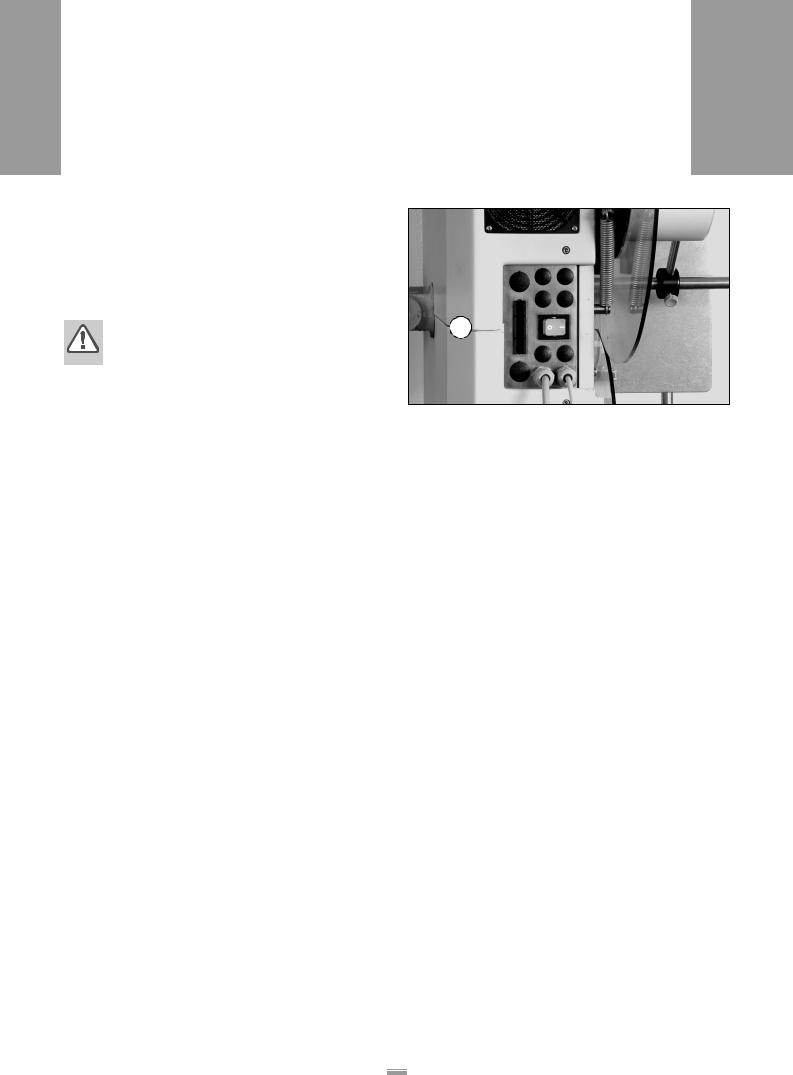
2 EQUIPMENT DESCRIPTION
2.2 OPERATOR CONTROLS
2.2.2 Main switch
–The main switch [8] is located to the left on the housing.
–The main switch is used to switch the machine on and off.
WARNING!
Contact with energised components can result in life-endangering currents through the body as well as burns. Voltage continues to be present in the housing even when switched off.
Only put the machine into operation when installed in a correctly installed housing.
Maintain the machine in a dry condition.
ALS 380
A

[8]Main switch on the housing
17

2 EQUIPMENT DESCRIPTION
2.3 CONTROL SYSTEM
2.3.1 Brief description
All of the machine’s functions are electronically controlled. Using the operator panel, the operators, calibration technicians, or service personnel have several options for adapting the machine's functions to current requirements.
The LED indicator gives the operator feedback messages regarding the current operating state of the machine. Error messages or warning messages appear on the display as necessary.
Before each operation, the operator must check and adjust the occasionally changing settings such as the label position on the product or the dispensing speed. These settings can simply be input at any time by the operator at the operator panel.
Task-specific data such as label distance or product length are programmed at the beginning of a job. As a rule, the settings are not modified as long as the job is being processed. This data input requires in-depth knowledge and may only be carried out by trained and instructed personnel (calibration technicians).
Databanks are available for variable or frequently recurring task settings. The task-specific settings can be saved in a databank. If the settings are needed again after a product change, it is not necessary to re-input the data. You only need to call up the corresponding databank. In all, 11 databanks are available.
Only calibration technicians may administer the product databanks.
ALS 380
It is also possible to modify the basic machine settings. These are settings such as the motor’s direction of rotation. These settings are not to be changed in normal operation. They may only be changed by servicing personnel or the responsible servicing technician.
To give the operator a better overview, the setting options for occasionally changing settings, task-specific data, databanks, and basic settings are grouped together in menus: The standard menu, extended menu, product databanks, and configuration menu. The following table provides an overview of the range of functions of the standard menu, extended menu, and product databanks. The configuration menu is described in the service guide.
CAUTION!
Erroneous settings can lead to production setbacks, damage to the machine and sys-  tem, and can even cause work-related acci-
tem, and can even cause work-related acci-
dents!
–Only specially trained and instructed personnel may alter the settings in the extended menu or access the product databanks.
18
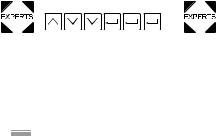
|
2 |
EQUIPMENT DESCRIPTION |
ALS |
|
2.3 |
CONTROL SYSTEM |
380 |
|
|
||
|
|
|
|
2.3.2 Menus for operators and calibration technicians
Menu |
Standard menu |
|
Extended menu |
Product databanks |
|||
|
|
|
|
|
|
|
|
Functions |
ON |
|
ON |
|
ON |
||
|
|
|
|
|
|
|
|
|
OFF |
|
OFF |
|
OFF |
||
|
|
|
|
|
|
|
|
|
INIT |
|
INIT |
|
PD01 |
||
|
|
|
|
|
|
|
|
|
VELO |
|
VELO |
|
PD02 |
||
|
|
|
|
|
|
|
|
|
STOD |
|
STOD |
|
PD03 |
||
|
|
|
|
|
|
|
|
|
POS |
|
POS |
PD04 |
|||
|
|
|
|
|
|
|
|
|
|
|
POS 2 |
PD05 |
|||
|
|
|
|
|
|
|
|
|
|
|
POS 3 |
PD06 |
|||
|
|
|
|
|
|
|
|
|
|
|
VERT |
|
PD07 |
||
|
|
|
|
|
|
|
|
|
|
|
CONT |
PD08 |
|||
|
|
|
|
|
|
|
|
|
|
|
E–SS |
|
PD09 |
||
|
|
|
|
|
|
|
|
|
|
|
LPIT |
|
PD10 |
||
|
|
|
|
|
|
|
|
|
|
|
PRDL |
PD11 |
|||
|
|
|
|
|
|
|
|
|
|
|
P_S_ |
|
|
|
|
|
|
|
|
|
|
|
|
|
|
|
S_S_ |
|
|
|
|
|
|
|
|
|
|
|
|
|
|
|
MLAB |
|
|
|
|
|
|
|
|
|
|
|
|
|
|
|
PDT |
|
|
|
|
|
|
|
|
|
|
|
|
|
|
|
PDWT |
|
|
|
|
|
|
|
|
|
|
|
|
|
|
|
EGRA 1) |
|
|
|
|
|
|
|
TMOD |
|
|
|
|
|
|
|
|
|
|
|
|
|
|
|
APPL |
|
|
|
|
|
|
|
|
|
|
|
|
|
|
|
APT1 |
|
|
|
|
|
|
|
|
|
|
|
|
|
|
|
APT2 |
|
|
|
|
|
|
|
|
|
|
|
|
|
|
|
APT3 |
|
|
|
|
|
|
|
|
|
|
|
|
|
|
|
APT4 |
|
|
|
|
|
|
|
|
|
|
|
|
|
|
|
LOAD |
|
|
|
|
|
|
|
|
|
|
|
|
|
|
|
SAVE |
|
|
|
|
|
|
|
|
|
|
|
|
|
|
|
DEL |
|
|
|
|
|
|
|
|
|
|
|
|
|
|
|
QUIT |
|
|
|
|
|
|
|
|
|
|
|
|
|
|
|
|
|
|
|
|
Activating a |
Main switch + NEXT |
|
|
PRIOR + NEXT |
|
|
Main switch + |
|
|
|
|||||
|
|
|
|||||
menu |
|
|
|
|
|
|
PRIOR |
|
|
|
|
|
|
|
|
|
|
|
|
|
|
|
|
|
|
|
|
|
|
|
|
1) Not ALS 380HS
19
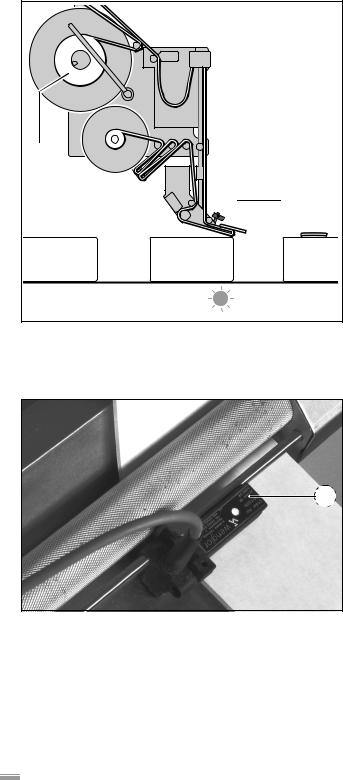
|
2 |
EQUIPMENT DESCRIPTION |
ALS |
|
2.3 |
CONTROL SYSTEM |
380 |
|
|
||
|
|
|
|
2.3.3 Monitoring functions
During labelling operation, the electronic control system and the sensors monitor the following functions.
Dispensing a label to each product
–A photoelectric sensor (product sensor) sends a signal when a product reaches the dispensing
edge [9B]. The signal from the product sensor triggers the label feed for a single label.
–If individual labels are missing from the label ribbon, the label feed compensates for this and advances the label ribbon by one additional label distance (label compensation).
–If label compensation does not take place before the next start signal of the product sensor, the product does not get labelled. A warning message appears at the operator panel.
–If the number of unlabelled products exceeds a certain value, the machine stops.
Label supply
–If no more labels arrive at the label stop sensor [9A] [10A], the machine stops and sends a signal to the output to the system controller.
–Install roll diameter control (optional):
If the diameter of the label roll on the unwinding spool [9C] becomes too small, the control system sends a warning message and a signal to the output to the system controller. The diameter at which the signal will be sent can be set by servicing technicians.
If errors occur
If a malfunction occurs, the control system sends a corresponding message to the operator. If necessary, the labelling operation is automatically halted. The machine simultaneously sends a signal to the system controller.
C |
A |
B |
[9]A Label stop sensor
B The product sensor sends a signal when the product has reached the dispensing edge.
C Label roll on the unwinding spool
 A
A
[10] Backing material with a label under the label stop sensor (A)
20

|
3 |
PRIOR TO OPERATING |
ALS |
|
3.1 |
INSERT THE LABELLING MATERIAL |
380 |
|
|
||
|
|
|
|
3.1.1 Prerequisites
–The label dispenser is switched off at the main [11A] switch.
Verify flawless functioning of the safety equipment. |
A |
Check machine for visible damage. Any discovered |
|
deficiency is to be reported immediately. |
|
Non-required materials and objects are to be re- |
|
moved from the working area of the machine. |
|
Make sure that only persons authorised to work on |
|
|
the machine are within the working area of the ma- |
[11] Main switch on the housing |
|
chine. |
|
Use required personal safety gear in accordance |
|
|
|
with the regulations, e.g. wear hair nets, and protec- |
|
|
tive eye-glasses. |
|
3.1.2 Insert the label roller |
|
|
|
WARNING! |
|
|
Risk of injury due to moving or rapidly rotat- |
|
|
ing parts! |
|
|
Before inserting the label roller, ensure |
|
|
that the machine is switched off at the |
|
|
main switch. |
|
|
Never switch on the machine before the |
|
|
label ribbon has been completely thread- |
|
|
ed into position. |
|
Remove the old backing material |
A |
|
|
||
If backing material remains on the rewinding [12A] |
|
|
roller: |
|
|
Swing the lever [12C] at the rewinding roller over the |
|
|
|
red [12B] point. |
|
– |
The tension of the rewinding roller spreader mecha- |
|
|
nism is relieved. |
|
Remove the rewound backing material. |
B |
|
Remove adhesive residues |
|
|
If necessary, clean the following components: |
|
|
– |
Dispensing edge |
|
– Deflection rollers and drive roller unit in the dispens- |
C |
|
|
er head |
|
– Dancer arm rollers and deflection rollers |
|
|
– |
Rewinding roller |
[12] Remove the backing material from the rewinding roller |
|
|
|
|
|
A Old backing material |
|
|
B Red point on the rewinding roller |
|
|
C Lever for the spreader mechanism of the rewinding roller |
21
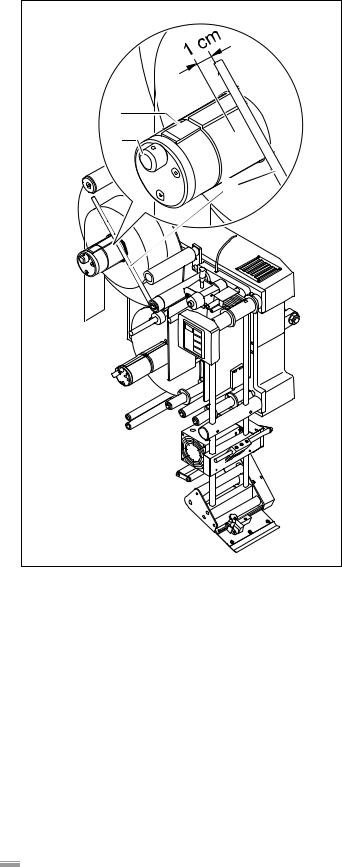
|
3 |
PRIOR TO OPERATING |
ALS |
|
3.1 |
INSERT THE LABELLING MATERIAL |
380 |
|
|
||
|
|
|
|
Insert new label roll
Only top-labeller:
Loosen the set-screw at the guiding rod [13C] and swing the guiding rod to the side.
All design versions:
Rotate the knurled knob [13B] clockwise, to retract the chucking wedge [13A] in the unwinding spindle.
If there is still an old roll core on the unwinding spindle: remove the old roll core.
Completely push on the new label roll.
Rotate the knurled knob counter-clockwise to secure the label roll on the unwinding spindle.
Also for top-labeller:
Also secure the label roll to the dancer arm in the axial direction:
Allow the dancer arm to lightly rest against the label roll and
swing it approximately 1 cm over the unwinding spindle. The dancer arm must not be allowed to touch the unwinding spindle.
Tighten the set-screw at the guiding rod.
A |
B |
C |
[13]New label roll on the unwinding spindle, secured to the guiding rod on the side
A Chucking wedge in the unwinding spindle B Knurled knob on the unwinding spindle C Guiding rod
22
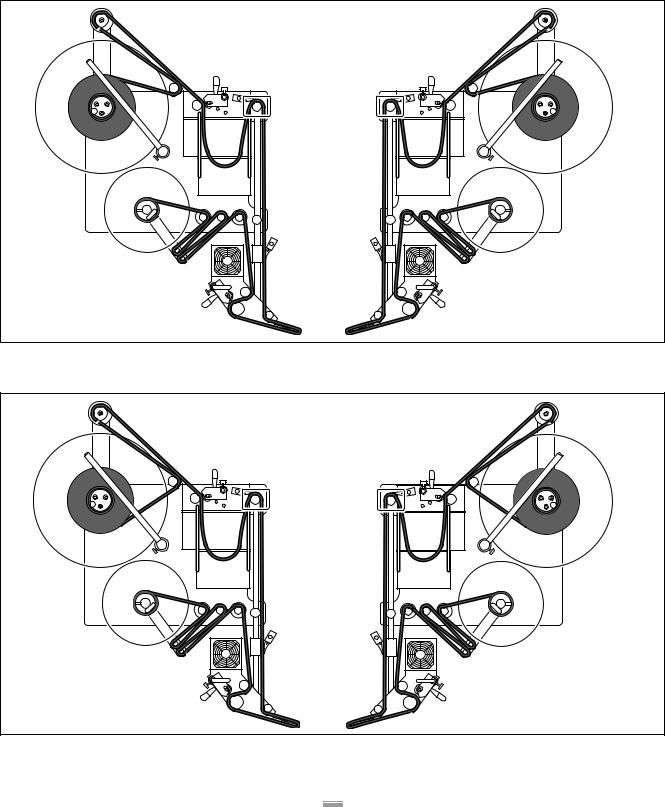
|
3 |
PRIOR TO OPERATING |
ALS |
|
3.1 |
INSERT THE LABELLING MATERIAL |
380 |
|
|
||
|
|
|
|
3.1.3 Threading the label ribbon
Overview of the threading path diagram
A |
B |
[14] Threading path diagram for label ribbon with the labels on the outside |
|
A Right-hand version |
B Left-hand version |
A |
B |
[15] Threading path diagram for label ribbon with the labels on the inside |
|
A Right-hand version |
B Left-hand version |
23
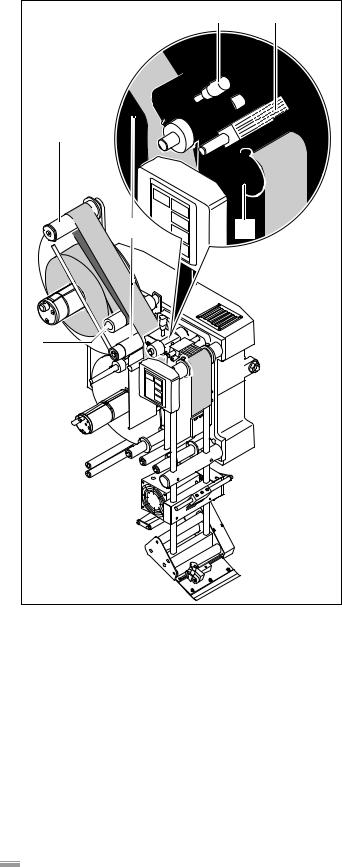
|
3 |
PRIOR TO OPERATING |
ALS |
|
3.1 |
INSERT THE LABELLING MATERIAL |
380 |
|
|
||
|
|
|
|
Thread the label ribbon at the unwind unit.
Swing up the pressure roller [16B] and the braking brush [16C].
Thread the label ribbon around the deflection roller [16E], dancer armroller [16A] and drive roller unit [16D].
Form a loop after the drive roller unit and guide the label ribbon over the operator panel support [16F].
Swing the pressure roller and web brake back into position.
–The pressure roller and braking brush click into operating position.
B |
C |
A |
|
D |
F |
E |
|
[16]Guides for the label ribbon in the unwinding section A Dancer arm roller
B Pressure roller C Braking brush D Drive roller unit E Deflection roller
F Operator panel support
24
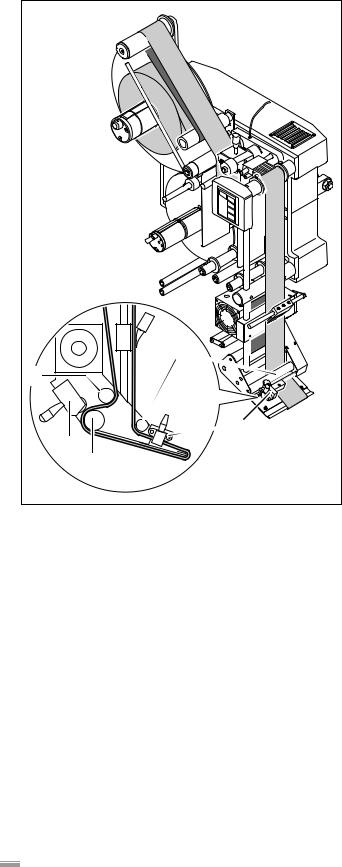
|
3 |
PRIOR TO OPERATING |
ALS |
|
3.1 |
INSERT THE LABELLING MATERIAL |
380 |
|
|
||
|
|
|
|
Thread in the label ribbon at the dispensing edge.
Swing up the pressure roller [17D] behind the dispensing edge.
Unthread approximately 2 m of label ribbon from the label roll.
Guide the label ribbon around the first deflection roller [17A] and through the slot in the photoelectric sensor [17B] for the dispensing edge.
Guide the label ribbon around the dispensing edge to the drive roller unit [17C].
Thread the label ribbon around the drive roller unit and the second deflection roller [17E].
Swing the pressure roller back into operating position.
A |
E |
B |
D |
C |
[17]Guides for the label ribbon at the dispensing edge A 1st Deflection roller
B Label stop sensor C Drive roller unit
D Pressure roller (shown here in operating position) E 2nd Deflection roller
25
